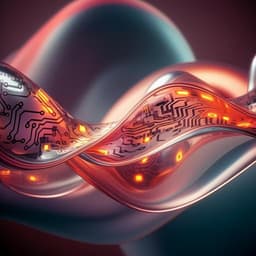
Engineering and Technology
Customizing a self-healing soft pump for robot
W. Tang, C. Zhang, et al.
Explore the innovative world of soft robotics with research conducted by Wei Tang and colleagues from Zhejiang University. Their groundbreaking work reveals soft electronic pumps that enable untethered robotic motions, merging self-healing liquid properties and portability to redefine how robots interact with humans.
~3 min • Beginner • English
Introduction
The study addresses the need for universal, portable power sources for untethered soft robots that balance powerful actuation, speed, controllability, reliability, and compactness. Conventional pneumatic/hydraulic actuation requires bulky compressors, limiting portability. Other approaches—combustion-driven pumps, thermal phase-transition systems, magnetic and light-responsive actuators—suffer trade-offs in control, speed, reusability, or need for external equipment. Inspired by spiders’ bio-hydraulic system, which uses a heart to pump hemolymph to drive agile movements and benefits from self-healing biological fluids, the authors propose fully soft, built-in electronic pumps capable of strong, controllable, bidirectional pumping and self-healing when paired with a functional liquid. The purpose is to create customizable, soft power sources suitable for diverse untethered soft robots, and to demonstrate their performance and utility in robot prototypes.
Literature Review
The paper surveys soft actuation modalities: pneumatic/hydraulic systems (prevalent but tethered due to compressors/pumps), combustion-driven power sources (high pressure and speed but difficult control and reuse), thermal phase-transition actuators (large force, slow response), and magnetic or light-responsive actuation (useful at micro/nano scales but require complex/bulky external equipment). Stretchable electrohydrodynamic (EHD) pumps have emerged to embed pumping within soft robots, improving portability, but with limited flow rate and output force for many applications. The authors position their soft electronic pumps with needle–hole electrode architecture as addressing these gaps by delivering higher pressures/flow rates, rapid response, controllability, robustness, diverse geometries, and easy fabrication, exceeding prior stretchable EHD pumps and providing advantages over combustion and thermal systems. They compare performance with commercial pumps/compressors and human heart benchmarks, highlighting higher specific pressure and flow rate.
Methodology
System design and architecture: Fully soft electronic pumps are constructed from all-soft-matter components: two soft ring positive electrodes with needle tips (conductive silicone 50A), a soft ring grounding electrode with holes (conductive silicone 60A), soft insulating supports (silicone 30A), and a soft elastomer shell (silicone 5A or PDMS). Needle tips align with ring holes to form modular needle–hole electrode pairs. Two positive electrodes are symmetrically placed around the ground ring, enabling reversible bidirectional pumping by selective high-voltage activation of opposite pairs. Multiple modules can be arranged in series/parallel to tune pressure and flow. Prototypes weigh as low as 3 g.
Operational principle: Under a strong non-uniform electric field between needle (positive) and ring (ground) electrodes, electrons detach from neutral liquid molecules near the needle, becoming free electrons absorbed by the positive electrode. The molecules become positive ions, which migrate toward the ground electrode under Coulomb forces, dragging neutral molecules and producing a jet through the hole. At the ground electrode, ions recombine with electrons, reforming neutral molecules. Flow persists under the applied field and stops when removed. A theoretical model (continuity, steady Navier–Stokes with Coulomb body force, Gauss’s law, current density including drift, diffusion, and conduction, and charge conservation with injected charge density above a threshold surface field) is implemented in COMSOL to compute potential, charge density, and velocity fields.
Functional liquids and self-healing formulation: Three liquids are used: dibutyl sebacate (DBS), linalyl acetate (LA), and a self-healing DBS–tung oil solution (volume ratio 2:1 DBS:tung oil). Tung oil contains conjugated C=C bonds and oxygen-linked fatty residues; upon air exposure it forms a solid film via free-radical autoxidative polymerization, enabling autonomous sealing of leaks when the liquid contacts air at a damage site. Linalyl acetate–tung oil shows similar behavior. Self-healing is air-dependent and not effective underwater. Viscoelastic properties of the cured film are characterized by DMA; adhesion to silicone is assessed by repeated tensile cycling of silicone with locally healed film.
Fabrication: A four-step molding and casting process produces the soft needles (conductive silicone coated onto silicone supports), ring electrodes (cut from conductive silicone sheets), shells (silicone 5A or PDMS), and final assembly aligning needles to ring holes. Electrical resistances are measured for quality control.
Power electronics: A lightweight, miniature two-output high-voltage power converter (HVPC) converts battery or wirelessly received low voltage to dual high-voltage outputs for bidirectional pumping. Each DC HVPC uses a NE555-based pulse oscillator, MOSFET IRF540N flyback inverter, high-frequency transformer, and voltage doubler rectifier. Transformers are separated by a non-magnetic shim to reduce EMI.
Wireless power transfer (WPT): A tiled two-layer array of emitting coils (50 total; 27 bottom, 23 top; coil diameter ~70 cm) is controlled via relays and a microcontroller to sequentially energize coils under the robot path. The robot carries two receiving coils (~35 cm diameter) and rectification electronics. Effective transfer distance ~15 mm, output ~7 V, ~1.5 A.
Performance testing: Custom LabVIEW control, DAQ, and a Trek 20/20C high-voltage amplifier generate test voltages; oscilloscope monitors signals. Pressure tests use a manometer; flow tests use a graduated cylinder and timing; all components at equal height to remove hydrostatic bias. For each pump version, three devices are fabricated and each tested three times to compute mean and standard deviation. Response time and bidirectional switching are characterized. Lifetime is assessed at 15 kV for 4 hours. Frequency limit is determined. Series and parallel integration effects are measured. Effects of needle diameter, hole diameter, and inter-electrode gap on performance are quantified.
Robotic demonstrations: 1) A soft robotic fish with a circular pump actuating a two-chamber bending tail; onboard HVPC and lithium battery enable bidirectional tail swings and untethered quiet swimming. 2) A robotic vehicle with a square pump driving a linear actuator, four wheels with one-way bearings, and onboard HVPC powered by WPT; locomotion occurs via alternating elongation/contraction cycles exploiting unidirectional wheel friction. Self-healing of punctures is demonstrated in the vehicle.
Model and material parameters: DBS-based fluid properties measured: density ~938 kg/m³; viscosity 7.5×10⁻³ Pa·s; relative permittivity ~4.5 (1 GHz); conductivity ~3.4×10⁻¹⁰ S/m; ion mobility ~6.93×10⁻⁸ m²/V·s. COMSOL simulations of a single pair predict flow rate matching experiments within −3.4% at 16 kV.
Key Findings
- Customizable performance: Generated pressure scales quadratically with voltage and is strongly influenced by liquid type and electrode geometry. Decreasing needle diameter, hole diameter, and electrode gap increases electric field strength and pressure; decreasing needle diameter and electrode gap increases flow rate.
- Peak performance: Maximum measured flow rate ~521 ml/min. A lightweight 3 g, 0.68 cm-thick pump achieves ~9.2 kPa pressure and ~423 ml/min flow. A pump integrating nine needle–hole pairs in series delivers >60 kPa pressure and >350 ml/min flow, comparable to similarly sized commercial pumps.
- Specific performance and power: Specific pressure ~3066.67 kPa/kg and specific flow rate ~141,000 ml min⁻¹ kg⁻¹, surpassing several commercial pumps/compressors and human heart benchmarks. Maximum power consumption ~3.6 W at ~16 kV and ~225 µA.
- Dynamics and durability: Response (peak) time ~0.45 s; bidirectional switching response ~0.58 s; operational frequency limit ~10 Hz. Lifetime test at 15 kV for 4 h shows durability; electrodes passivate over time, causing pressure to drop then stabilize.
- Self-healing: DBS–tung oil self-healing liquid seals punctures upon air exposure; healing times ~6 h at 35 °C and ~1 day at 24 °C. Healed systems operate continuously for 2 h without leakage. The cured film is transparent, elastic; storage modulus ~14.3 kPa (20 °C), ~13.2 kPa (25 °C), ~10.6 kPa (30 °C); loss modulus ~3.1, ~2.5, ~2.1 kPa respectively. Strong adhesion to silicone persists after 200 tensile cycles at 20% strain; mechanical properties of pristine vs. self-healed samples are similar.
- Demonstrations: Bidirectional pumping between reservoirs with controllable times (e.g., total ~18.1 s at 16 kV) validates fast, reversible operation. Untethered robotic fish exhibits rapid tail actuation and silent swimming with onboard HVPC and battery. Robotic vehicle achieves forward motion powered by WPT via cyclic linear actuation. Self-healing of the vehicle’s fluidic system is shown.
- Comparative advantages: Compared with soft combustion-driven pumps achieving ~60 kPa and ~40 ml/min, the presented pumps reach similar pressure but much higher flow (~350 ml/min) with better controllability, reusability, and robustness; they also outperform prior stretchable EHD pumps in pressure/flow and design versatility.
Discussion
The findings demonstrate that fully soft electronic pumps based on electron/ion migration in low-conductivity functional liquids can deliver strong, fast, and controllable pumping in compact, lightweight, and conformable architectures suitable for embedding in soft robots. The modular needle–hole electrode design enables bidirectional operation, easy series/parallel scaling, and broad geometric customization to match varied robot morphologies. The integration of a self-healing functional liquid imparts autonomous sealing of punctures, enhancing robustness and service life in unstructured environments—an analogue to biological hemolymph. Benchmarked against commercial pumps and alternative soft actuation modalities, the devices show favorable specific performance, rapid response, and long-term operation, fulfilling key requirements for untethered soft systems. Robotic demonstrations of an underwater fish (battery powered) and a ground vehicle (wireless powered) validate that the pumps can serve as universal, built-in power sources enabling diverse, quiet, and reversible motions without tethers. The theoretical and numerical model aligns with experiments, supporting the proposed electrohydrodynamic mechanism and guiding further optimization.
Conclusion
This work introduces fully soft, customizable electronic pumps that combine high specific pressure and flow, rapid bidirectional response, portability, and self-healing capability via a DBS–tung oil functional liquid. The all-soft architecture and modular needle–hole electrodes allow straightforward tuning of geometry and performance through electrode design, liquid selection, and series/parallel integration. A miniature dual-output HVPC and optional wireless power system enable complete implantation in soft robots, demonstrated in an untethered fish and a wireless-powered vehicle. Future directions suggested by the results include: optimizing functional liquids (e.g., lower viscosity, higher ion generation while maintaining low conductivity) and electrode geometries to further raise pressure/flow; improving HVPC efficiency and EMI mitigation; scaling pumps across sizes via multi-material 3D printing; enhancing operation frequency and longevity; and developing self-healing strategies effective in aquatic environments.
Limitations
- Self-healing requires air exposure; it does not occur underwater, limiting autonomous sealing in submerged scenarios.
- High-voltage operation (up to ~16 kV) necessitates specialized converters and insulation; potential EMI and safety considerations remain.
- Electrodes undergo passivation during extended high-voltage use, reducing pressure before stabilization.
- Frequency limit around ~10 Hz constrains very high-speed actuation.
- Healing times are relatively long (hours), which may interrupt operation depending on application.
- Demonstrations focus on two robot types; broader integration and long-term field tests were not reported in detail.
Related Publications
Explore these studies to deepen your understanding of the subject.







